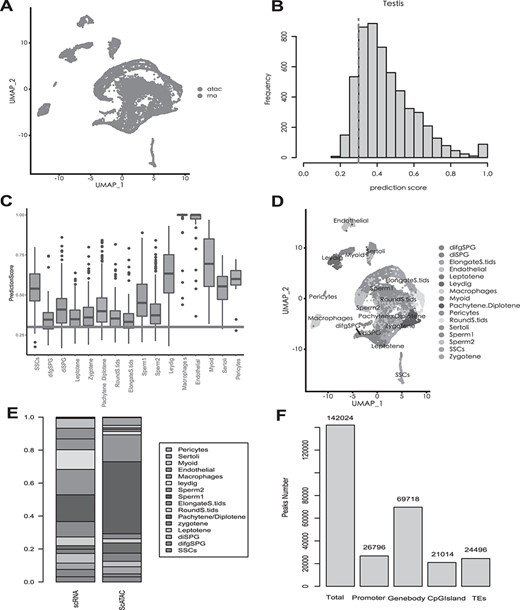Single-cell ATAC-Seq reveals cell type-specific transcriptional regulation and unique chromatin accessibility in human spermatogenesis.
Wu X, Lu M, Yun D, Gao S, Chen S, Hu L, Wu Y, Wang X, Duan E, Cheng CY, Sun F, 12.01.2021
Abstract
During human spermatogenesis, germ cells undergo dynamic changes in chromatin organization/re-packaging and in transcriptomes. In order to better understand the underlying mechanism(s), scATAC-Seq of 5376 testicular cells from 3 normal men were performed. Data were analyzed in parallel with the scRNA-Seq data of human testicular cells. In all, 10 germ cell types associated with spermatogenesis and 6 testicular somatic cell types were identified, along with 142 024 peaks located in promoter, genebody and CpG Island. We had examined chromatin accessibility of all chromosomes, with chromosomes 19 and 17 emerged as the leading chromosomes that displayed high chromatin accessibility. In accessible chromatin regions, transcription factor-binding sites were identified and specific motifs with high frequencies at different spermatogenesis stages were detected, including CTCF, BORIS, NFY, DMRT6, EN1, ISL1 and GLI3. Two most remarkable observations were noted. First, TLE3 was specifically expressed in differentiating spermatogonia. Second, PFN4 was found to be involved in actin cytoskeletal organization during meiosis. More important, unique regions upstream of PFN4 and TLE3 were shown to display high accessibility, illustrating their significance in supporting human spermatogenesis.
Wu X, Lu M, Yun D, Gao S, Chen S, Hu L, Wu Y, Wang X, Duan E, Cheng CY, Sun F. Single-cell ATAC-Seq reveals cell type-specific transcriptional regulation and unique chromatin accessibility in human spermatogenesis. Hum Mol Genet. 2022 Feb 3;31(3):321-333. doi: 10.1093/hmg/ddab006. PMID: 33438010.
Publication: https://doi.org/10.1093/hmg/ddab006
 Disclaimer
Disclaimer
The publication Single-cell ATAC-Seq reveals cell type-specific transcriptional regulation and unique chromatin accessibility in human spermatogenesis. by Wu X, Lu M, Yun D, Gao S, Chen S, Hu L, Wu Y, Wang X, Duan E, Cheng CY, Sun F is published under an open access license: https://s100.copyright.com/AppDispatchServlet?publisherName=OUP&publication=1460-2083&title=Single-cell%20ATAC-Seq%20reveals%20cell%20type-specific%20transcriptional%20regulation%20and%20unique%20chromatin%20accessibility%20in%20human%20spermatogenesis&pu. Journals content which is published and distributed under the Oxford University Press (OUP) Journals, Standard Publication Model is published on an exclusive licence or copyright assignment basis, and reuse rights are retained and controlled by OUP.
Curation by the MFGA team Relevant data sets presented in the publication have been identified. If possible, annotations (title, general information, conditions, processed tissue types and processed cell types) have been added based on information from the publication. Data tables and images that provide a good overview on the publication's findings on the data set have been extracted from the publication and/or supplement. If not stated otherwise, images are depicted with title and description exactly as in the publication. Tables have been adjusted to the MFGA table format. Conducted adjustments are explained in the detailed view of the tables. However, titles and descriptions have been adopted from the publication.
Data set 1: scRNA-Seq data analysis recognize 10 germ cell types and 6 somatic cell types
Transcriptome: Single-cell RNA-Sequencing
Species
| Species |
|---|
| Human |
Tissue Types
| BRENDA tissue ontology | Maturity | Description | Species | Replicates |
|---|---|---|---|---|
| BTO_0001363: testis | A typically paired male reproductive gland that produces sperm and that in most mammals is contained within the scrotum at sexual maturity. |
Cell Types
| Cell ontology | Maturity | Description | Species | Replicates | Cells per replicate |
|---|---|---|---|---|---|
| CL_0000020: spermatogonium | An euploid male germ cell of an early stage of spermatogenesis. | ||||
| CL_0000017: spermatocyte | A male germ cell that develops from spermatogonia. The euploid primary spermatocytes undergo meiosis and give rise to the haploid secondary spermatocytes which in turn give rise to spermatids. | ||||
| CL_0000018: spermatid | A male germ cell that develops from the haploid secondary spermatocytes. Without further division, spermatids undergo structural changes and give rise to spermatozoa. |
Images

Figure 1: Results of scRNA-Seq data analysis.
(A) Umap plot of adult human testicular cells. Different shades of gray based on cell types we identified are shown. (B) Expression of marker genes in different cell types (dot plot). The dot size and dot grayscale represent expression percentage and expression average, correspondingly. (C) Expression patterns (violin plots) of partial marker genes.
Data set 2: Preliminary analysis of scATAC-Seq
Epigenome: Single-cell ATAC Sequencing
Species
| Species |
|---|
| Human |
Tissue Types
| BRENDA tissue ontology | Maturity | Description | Species | Replicates |
|---|---|---|---|---|
| BTO_0001363: testis | A typically paired male reproductive gland that produces sperm and that in most mammals is contained within the scrotum at sexual maturity. |
Cell Types
| Cell ontology | Maturity | Description | Species | Replicates | Cells per replicate |
|---|---|---|---|---|---|
| CL_0000020: spermatogonium | An euploid male germ cell of an early stage of spermatogenesis. | ||||
| CL_0000017: spermatocyte | A male germ cell that develops from spermatogonia. The euploid primary spermatocytes undergo meiosis and give rise to the haploid secondary spermatocytes which in turn give rise to spermatids. | ||||
| CL_0000018: spermatid | A male germ cell that develops from the haploid secondary spermatocytes. Without further division, spermatids undergo structural changes and give rise to spermatozoa. |
Images

Figure 2: Cell selection and preliminary analysis combining data of scATAC-Seq and scRNA-Seq.
(A) Umap plot of cells. Different shades of gray represent cells from scATAC-Seq and scRNA-Seq. (B) Cell number of different scATAC-Seq cell prediction scores displayed by bar plot. We set 0.3 as threshold (black dashed line) to select cells for the following analysis. There are 4685 cells in whole 5376 cells satisfied our condition. (C) scATAC-Seq cell prediction score of different stage cell types from (B). (D) Umap plot of cells from (A). Cell types are shown by different shades of gray. (E) Percentage of different cell types in cells selected frrm (B) classified by scRNA-Seq and scATAC-Seq. (F) Number of peaks in different locations displayed by bar plot.
